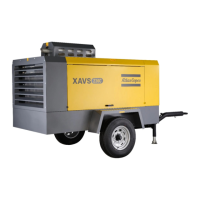- 11 -
21 When using compressed air or inert gas to clean
down equipment, do so with caution and use the
appropriate protection, at least safety glasses, for
the operator as well as for any bystander. Do not
apply compressed air or inert gas to your skin or
direct an air or gas stream at people. Never use it
to clean dirt from your clothes.
22 When washing parts in or with a cleaning solvent,
provide the required ventilation and use
appropriate protection such as a breathing filter,
safety glasses, rubber apron and gloves, etc.
23 Safety shoes should be compulsory in any
workshop and if there is a risk, however small, of
falling objects, wearing of a safety helmet should
be included.
24 If there is a risk of inhaling hazardous gases,
fumes or dust, the respiratory organs must be
protected and depending on the nature of the
hazard, so must the eyes and skin.
25 Remember that where there is visible dust, the
finer, invisible particles will almost certainly be
present too; but the fact that no dust can be seen
is not a reliable indication that dangerous,
invisible dust is not present in the air.
26 Never operate the unit at pressures or speeds
below or in excess of its limits as indicated in the
technical specifications.
27 Never operate the generator in excess of its limits
as indicated in the technical specifications and
avoid long no-load sequences.
28 Never operate the generator in a humid
atmosphere. Excessive moisture causes
worsening of the generator insulation.
29 Do not open electrical cabinets, cubicles or other
equipment while voltage is supplied. If such
cannot be avoided, e.g. for measurements, tests or
adjustments, have the action carried out by a
qualified electrician only, with appropriate tools,
and ascertain that the required bodily protection
against electrical hazards is applied.
30 Never touch the power terminals during operation
of the machine.
31 Whenever an abnormal condition arises, e.g.
excessive vibration, noise, odour, etc., switch the
circuit breakers to OFF and stop the engine.
Correct the faulty condition before restarting.
32 Check the electric cables regularly. Damaged
cables and insufficient lightening of connections
may cause electric shocks. Whenever damaged
wires or dangerous conditions are observed,
switch the circuit breakers to OFF and stop the
engine. Replace the damaged wires or correct the
dangerous condition before restarting. Make sure
that all electric connections are securely
tightened.
33 Avoid overloading the generator. The generator is
provided with circuit breakers for overload
protection. When a breaker has tripped, reduce
the concerned load before restarting.
34 If the generator is used as stand-by for the mains
supply, it must not be operated without control
system which automatically disconnects the
generator from the mains when the mains supply
is restored.
35 Never remove the cover of the output terminals
during operation. Before connecting or
disconnecting wires, switch off the load and the
circuit breakers, stop the machine and make sure
that the machine cannot be started inadvertently
or there is any residual voltage on the power
circuit.
36 Running the generator at low load for long
periods will reduce the lifetime of the engine.
SAFETY DURING MAINTENANCE AND
REPAIR
Maintenance, overhaul and repair work shall only be
carried out by adequately trained personnel; if
required, under supervision of someone qualified for
the job.
1 Use only the correct tools for maintenance and
repair work, and only tools which are in good
condition.
2 Parts shall only be replaced by genuine Atlas
Copco replacement parts.
3 All maintenance work, other than routine
attention, shall only be undertaken when the unit
is stopped. Steps shall be taken to prevent
inadvertent starting. In addition, a warning sign
bearing a legend such as ”work in progress; do
not start” shall be attached to the starting
equipment.
On
engine-driven units the battery shall be
disconnected and removed or the terminals
covered by insulating caps.
On electrically driven units the main switch shall
be locked in open position and the fuses shall be
taken out. A warning sign bearing a legend such
as ”work in progress; do not supply voltage” shall
be attached to the fuse box or main switch.
4 Before dismantling any pressurized component,
the compressor or equipment shall be effectively
isolated from all sources of pressure and the entire
system shall be relieved of pressure. Do not rely
on non-return valves (check valves) to isolate
pressure systems. In addition, a warning sign
bearing a legend such as ”work in progress; do
not open” shall be attached to each of the outlet
valves.
5 Prior to stripping an engine or other machine or
undertaking major overhaul on it, prevent all
movable parts from rolling over or moving.

